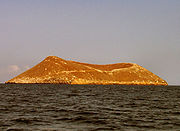
Daphne Major
Encyclopedia

Volcano
2. Bedrock3. Conduit 4. Base5. Sill6. Dike7. Layers of ash emitted by the volcano8. Flank| 9. Layers of lava emitted by the volcano10. Throat11. Parasitic cone12. Lava flow13. Vent14. Crater15...
island
Island
An island or isle is any piece of sub-continental land that is surrounded by water. Very small islands such as emergent land features on atolls can be called islets, cays or keys. An island in a river or lake may be called an eyot , or holm...
just north of Santa Cruz Island
Santa Cruz Island (Galápagos)
Santa Cruz Island is one of the Galápagos Islands with an area of and a maximum altitude of .Situated in the center of the archipelago, Santa Cruz is the second largest island after Isabela. Its capital is Puerto Ayora, the most populated urban centre in the islands. On Santa Cruz there are some...
and just west of the Baltra Airport in the archipelago Colon, commonly known as the Galápagos Islands
Galápagos Islands
The Galápagos Islands are an archipelago of volcanic islands distributed around the equator in the Pacific Ocean, west of continental Ecuador, of which they are a part.The Galápagos Islands and its surrounding waters form an Ecuadorian province, a national park, and a...
. It consists of a tuff
Tuff
Tuff is a type of rock consisting of consolidated volcanic ash ejected from vents during a volcanic eruption. Tuff is sometimes called tufa, particularly when used as construction material, although tufa also refers to a quite different rock. Rock that contains greater than 50% tuff is considered...
crater
Volcanic crater
A volcanic crater is a circular depression in the ground caused by volcanic activity. It is typically a basin, circular in form within which occurs a vent from which magma erupts as gases, lava, and ejecta. A crater can be of large dimensions, and sometimes of great depth...
, devoid of trees, whose rim rises 120 metres above the sea.
Though easily accessible to most visitors to the Galápagos, the national park service has highly restricted visits to this island, and it is primarily used for scientific research. An intensive study of Darwin's finches
Darwin's finches
Darwin's finches are a group of 14 or 15 species of passerine birds. It is still not clear which bird family they belong to, but they are not related to the true finches. They were first collected by Charles Darwin on the Galápagos Islands during the second voyage of the Beagle...
was conducted here by biologists Peter and Rosemary Grant
Peter and Rosemary Grant
Peter Raymond Grant and Barbara Rosemary Grant, a married couple, are both British evolutionary biologists at Princeton University; each holds the position of Emeritus Professor. They are noted for their work concerning Darwin's finches on the Galápagos Island named Daphne Major...
over a period of 20 years. They examined the behaviour and life cycles of finches, with the results strongly supporting Darwin
Charles Darwin
Charles Robert Darwin FRS was an English naturalist. He established that all species of life have descended over time from common ancestry, and proposed the scientific theory that this branching pattern of evolution resulted from a process that he called natural selection.He published his theory...
's theory of evolution
Evolution
Evolution is any change across successive generations in the heritable characteristics of biological populations. Evolutionary processes give rise to diversity at every level of biological organisation, including species, individual organisms and molecules such as DNA and proteins.Life on Earth...
. Their efforts were documented in the Pulitzer Prize winning book The Beak of the Finch
The Beak of the Finch
The Beak of the Finch: A Story of Evolution in Our Time is a 1994 nonfiction book about evolutionary biology, written by Jonathan Weiner. It won the 1995 Pulitzer Prize for General Non-Fiction. The finches of the title are the Galapagos or 'Darwin's Finches,' passerine songbirds in the Galapagos...
.
Daphne is home to a variety of other birds including Galápagos Martin
Galápagos Martin
The Galápagos Martin is a species of bird in the Hirundinidae family endemic to the Galápagos Islands in Ecuador.Its natural habitats are subtropical or tropical dry shrubland, subtropical or tropical seasonally wet or flooded lowland grassland, pastureland, and heavily degraded former...
s, Blue-footed Booby
Blue-footed Booby
The Blue-footed Booby is a bird in the Sulidae family which comprises ten species of long-winged seabirds. The natural breeding habitat of the Blue-footed Booby is tropical and subtropical islands off the Pacific Ocean, most famously, the Galápagos Islands, Ecuador.- Etymology :The name booby...
, Nazca Booby
Nazca Booby
The Nazca Booby, Sula granti, is a booby which is found in the eastern Pacific Ocean, namely on the Galápagos Islands where it can be seen by eco-tourists, and on Clipperton Island...
, Short-eared Owl
Short-eared Owl
The Short-eared Owl is a species of typical owl . In Scotland this species of owl is often referred to as a cataface, grass owl or short-horned hootlet. Owls belonging to genus Asio are known as the eared owls, as they have tufts of feathers resembling mammalian ears. These "ear" tufts may or may...
s, Red-billed Tropicbird
Red-billed Tropicbird
The Red-billed Tropicbird, Phaethon aethereus, also known as the Boatswain Bird is a tropicbird, one of three closely related seabirds of tropical oceans.-Distribution and habitat:...
s and Magnificent Frigatebird
Magnificent Frigatebird
The Magnificent Frigatebird was sometimes previously known as Man O'War, reflecting its rakish lines, speed, and aerial piracy of other birds....
s.

